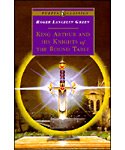
King Arthur and His Knights of the Round Table, Roger Lancelyn Green
(1953; Puffin Books, 1994) pb., 330 pp.
I really enjoyed the King Arthur stories as a boy and looked forward to reading them to my boys. There are various renditions of course (and I have gathered a number of them over the years), but this one is particularly interesting because it was done by a significant literary figure (and friend of C. S. Lewis). In his introduction, Green notes that the Arthurian legends are inconsistent and incoherent as they come from various sources. Green attempts here to draw them together into one story.
The inconsistency of the legends can be felt in the reading. In the early portion of the book I was often frustrated with the underlying worldview. Honor is often thought to be found in fighting and killing each other almost as sport. Oddly enough later in the book this idea is judged harshly, and the noble knight is the one who fights only when there is a just and necessary cause. Similarly, the pride of knights seems to be condoned in the earlier parts, but is severely criticized in the latter parts. My boys picked up on the inconsistency.
While the book seemed to start slow (this seems to be a recurring theme in my reviews), eventually my boys really got into it. Even with the faults, the stories are explicitly Christian. They intend to be Christian even when they fall short of a truly biblical worldview. This combined with my boys growing interest caused me to persevere with the reading. Along the way, and especially as we came to the latter half (roughly) of the book we found many good morals. Form the earlier part of the book, in the story of the brothers Balyn and Balan, there is a strong point of perseverance in spite of being placed in difficult circumstances. At one point Balan says to his brother:
“Many sad things have indeed befallen you,” said Balan, “but we must endure even the hardest adventures that God sends us.”
Here you have perseverance under the sovereign hand of God. This provided very useful fuel for discussion for perseverance in homework, etc. Somehow it resonates a bit more with my boys when tied to knighthood! Furthermore, as the story turns to the quest for the Holy Grail the issue of purity of heart, and resistance of temptation comes strongly to the fore. This too provided many useful opportunities for discussing various temptations and distractions which face us.
Anyone familiar with the basic story will know that some of the temptation that comes to various knights is sexual. However, Green handles this very tactfully. Sometimes he simply says that maidens tempted the knight without further explanation, or the temptation is phrased in terms of trying to get the knight to marry or kiss a maiden who is married to another. For my boys this was a very tasteful reminder of the sanctity of marriage and the preserving oneself (here represented as kissing) for marriage.
In the end, the story comes across as a significantly Christianized fable. It sounds almost like a thoroughgoing exhortation to Christian living in terms of medieval spirituality. Thus, it would need explanation and some editing, but with that it can be very useful.